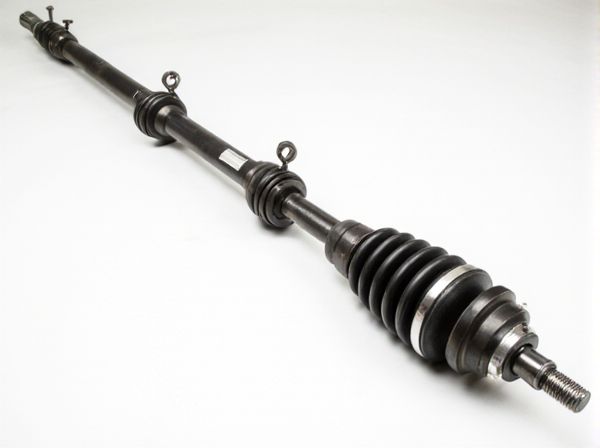
Photo illustration: Hollow Driveshaft vs Solid Driveshaft
A hollow driveshaft offers reduced weight and increased strength, improving fuel efficiency and performance by minimizing rotational mass. Solid driveshafts deliver superior durability and toughness, ideal for heavy-duty applications and high-torque demands. Your choice depends on balancing the need for lightweight efficiency against maximum strength for your specific vehicle requirements.
Table of Comparison
| Feature | Hollow Driveshaft | Solid Driveshaft |
|---|---|---|
| Weight | Lightweight, reduces overall vehicle weight | Heavier, adds to vehicle mass |
| Strength | High torsional strength with less weight | Strong and durable, resistant to bending |
| Durability | Good fatigue resistance, prone to impact damage | Excellent durability under heavy loads |
| Performance | Improves handling by reducing rotational inertia | Reliable, but may reduce acceleration efficiency |
| Cost | Higher manufacturing cost due to material and process | Lower cost, simpler to produce |
| Applications | Sports cars, performance vehicles | Trucks, heavy-duty vehicles |
Introduction to Driveshafts: Function and Importance
Driveshafts are critical components in automotive and industrial machinery, responsible for transmitting torque from the engine to the wheels or other mechanical parts. Hollow driveshafts offer reduced weight and increased flexibility, enhancing fuel efficiency and performance, while solid driveshafts provide superior strength and durability under high-stress conditions. Understanding the functional differences between hollow and solid driveshafts is essential for optimizing vehicle dynamics and reliability.
What is a Hollow Driveshaft?
A hollow driveshaft is a lightweight, tubular shaft made from high-strength steel or aluminum, designed to transmit torque from the engine to the wheels while reducing rotational mass. Compared to a solid driveshaft, it offers enhanced strength-to-weight ratio, improving vehicle performance, fuel efficiency, and reducing vibration. Hollow driveshafts are commonly used in sports cars and off-road vehicles for their superior durability and efficiency during high-speed rotations.
What is a Solid Driveshaft?
A solid driveshaft is a single-piece component typically made from steel or aluminum that transmits torque from the transmission to the differential in vehicles. It offers high strength and durability, making it suitable for heavy-duty applications requiring maximum power transfer. Compared to hollow driveshafts, solid driveshafts tend to be heavier but provide greater torsional rigidity and resistance to twisting under load.
Key Differences: Hollow vs Solid Driveshafts
Hollow driveshafts offer superior strength-to-weight ratios compared to solid driveshafts, reducing overall vehicle weight and enhancing performance by minimizing rotational inertia. Solid driveshafts, known for their robustness and simplicity, provide higher torsional rigidity but add more weight, which can impact fuel efficiency. The choice between hollow and solid driveshafts depends on application requirements, with hollow shafts favored in high-performance and racing vehicles for weight reduction, while solid shafts are preferred in heavy-duty or off-road vehicles for durability.
Strength and Durability Comparison
Hollow driveshafts offer superior strength-to-weight ratios due to their ability to resist torsional stress while reducing rotational mass, enhancing vehicle performance. Solid driveshafts provide exceptional durability and are less prone to bending or deformation under extreme loads, making them ideal for heavy-duty applications. The choice between hollow and solid driveshafts depends on specific strength requirements, with hollow shafts favored for weight-sensitive performance and solid shafts preferred for maximum durability in rugged conditions.
Weight Considerations: Hollow vs Solid
Hollow driveshafts weigh significantly less than solid driveshafts due to their tubular design, which reduces rotational mass and enhances vehicle performance. The lower weight of hollow driveshafts improves acceleration, fuel efficiency, and handling by decreasing the overall drivetrain inertia. In contrast, solid driveshafts, being heavier and denser, offer increased strength but can negatively impact vehicle dynamics due to their additional weight.
Performance and Efficiency Analysis
Hollow driveshafts offer superior performance and efficiency due to their reduced weight, which decreases rotational inertia and improves acceleration and fuel economy compared to solid driveshafts. The lower mass of hollow driveshafts also enhances drivetrain responsiveness and reduces stress on surrounding components, leading to increased durability and less vibration during high-speed operation. Solid driveshafts, while heavier and less efficient, provide greater torsional rigidity, making them suitable for applications requiring maximum strength and torque transmission.
Cost and Maintenance Factors
Hollow driveshafts generally offer lower maintenance costs due to their reduced weight, which decreases wear on associated drivetrain components and improves fuel efficiency. Solid driveshafts, while typically less expensive upfront, often incur higher maintenance expenses because their heavier weight can accelerate wear and necessitate more frequent repairs or replacements. Choosing between hollow and solid driveshafts requires considering the balance between initial cost savings and long-term maintenance investment.
Applications: Best Use Cases for Each Type
Hollow driveshafts are ideal for high-performance vehicles and off-road applications due to their lightweight design, which reduces rotational mass and enhances acceleration. Solid driveshafts excel in heavy-duty trucks and industrial machinery where maximum torque capacity and durability under extreme stress are critical. Choosing between hollow and solid driveshafts depends on balancing the needs for weight savings and strength according to the specific vehicle or equipment requirements.
Choosing the Right Driveshaft for Your Vehicle
Selecting the right driveshaft for your vehicle depends on factors such as weight, performance needs, and durability. Hollow driveshafts offer reduced weight and increased strength, improving acceleration and fuel efficiency, while solid driveshafts provide enhanced torque capacity and better resistance to bending under heavy loads. Evaluating your vehicle's power output, intended use, and budget ensures optimal performance and longevity by matching these characteristics with the appropriate driveshaft type.
 caratoz.com
caratoz.com